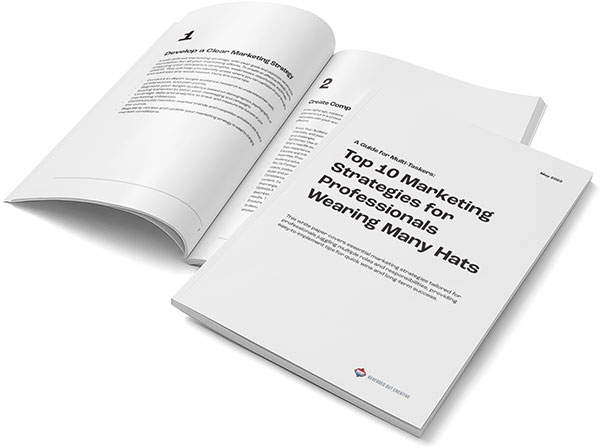
When it comes to being successful online, there’s a lot that goes into building a website and making it work. You have to know who you’re trying to reach, what they want from their visit, and how you’ll keep them coming back (and converting!) once they arrive. Of course, all this can be simplified by focusing on the things that make for a better web experience for your customers—that is, the folks who matter most in every digital marketing campaign! With this list of 10 steps in mind and some diligent effort from your team or agency partner along the way, there’s no telling how far you’ll go.
Know your audience.
To make the most of your website, you need to know who you’re trying to reach.
This includes:
- The problems they have
- The keywords they use
- Their needs and preferences
- Their demographics (age/gender/location)
- Their habits and buying cycle
Get customers where they’re looking.
While you’re at it, make sure to:
- Use the right keywords in your online content.
- Choose a domain name that’s easy for customers to remember and type into their browser.
- Use a URL structure that makes sense for your site’s content hierarchy and how people search for products or services like yours on Google.
- Write title tags, meta descriptions, and ALT attributes that are specific enough to help users find what they need while also being broad enough not to confuse them with another page on another website.
Use keywords.
- Title: Use keywords in your title tag.
- Description: Use keywords in your meta description.
- Content: Include appropriate keywords throughout your content, but don’t overdo it!
- Image Alt Tags: When uploading images on your website, be sure to include relevant keywords as alt tags. This will help search engines understand the contents of those images and help them rank higher when displayed on search engine results pages (SERPs).
- Meta Tags: If you are using a CMS like WordPress or Magento, there is an opportunity for you to add meta tags that contain your target keywords directly into the source code of every page of your site. These meta tags can also provide additional information about how people can contact you or find other content associated with what they’re searching for—like an event calendar or blog feed!
Focus on quality and originality.
While there are many things that can make your website more user-friendly and attractive, there is one major factor that will determine whether or not the customer will have a positive experience with your site: quality and originality.
Before you even begin to create content for your site, it is important to think about what kind of impression you want to give off as an organization. Are you looking for something professional? Do you want something fun? What kind of message do you want to convey? These questions should be discussed before any writing begins so everyone knows exactly what they’re getting into. If it turns out that one writer has different ideas than another, then maybe they shouldn’t be on the same team!
Make it easy to consume content.
The first step in providing a good user experience is making sure your content is easy for the user to consume.
You should make sure your text is readable and that it’s not too long or too short. Use headings, subheadings, and bullet points when appropriate. Use white space to break up long paragraphs of text into smaller sections that are easier on the eyes. Images are also a great way to break up text while adding more visual appeal to your site!
Create an engaging experience with minimal effort from them (your customers).
For example:
- Keep layouts simple without overdoing it with complex graphics or special effects.
- Use simple designs so they don’t feel overwhelmed by information overload.
- Add white space between elements throughout your website so they aren’t distracted by clutter.
- Create color schemes with limited number of shades so there aren’t any unnecessary distractions either.
Keep it fresh.
Keep your content fresh and have a blog that is updated regularly. By keeping an updated blog on your website, you’re showing value to your customers and give them faith that you’re knowledgable in the products/services you provide. In addition, traffic to your website will increase.
Simplify navigation.
When your navigation is easy to find and use, it’s a win for your customers.
Navigation should be consistent across all pages of your site, which means you need to make sure it’s the same on each page of content. A customer may click on an article link, but when they arrive at that page they realize they have no idea what section they’re in and how to get back out again.
You also want your navigation system to be intuitive. This will help reduce unnecessary clicks by allowing people who know where they want to go easily move around without having to think about how exactly that might happen (and thus increase their chances of staying on site).
Finally, make sure all parts of the navigation are easy-to-read! This includes font size as well as color contrast ratio (which refers more specifically about how text compares with its background).
Make sure your website is optimized for search engine optimization (SEO).
Search engine optimization is the process of improving a website’s search rankings in organic (unpaid) search results. SEO experts use SEO tactics to increase a website’s visibility, traffic and ranking in the search engines.
Broadly speaking, there are two main ways to improve your site’s SEO:
- On-page factors – the HTML code on each page of your site (for example, having keywords in headings and links)
- Off-page factors – how other pages link to yours
Optimize for mobile and tablet devices, too.
A website that doesn’t work well on mobile or tablet will lose you business. In fact, Google has said that it takes into account the mobile experience in its ranking algorithm, so it’s not just about having a better user experience—it could also mean more traffic and higher rankings in search results!
Responsive design is by far the easiest way to ensure your site works well across all devices. Most web designers use responsive design techniques these days (as they should), but if yours hasn’t yet made the leap, now is the time!
Don’t forget about the basics and keep paying attention to the little details that matter most to your audience.
It’s easy to get caught up in all the new technology that’s available, but sometimes you have to remember that there are things you can do to make your website better without spending a lot of money or time. Some of these include:
- Make sure your website is optimized for search engine optimization (SEO). This includes having keywords in your title tags, descriptions, and body content. You should also have links to other pages on your site within your text so that it can rank higher when someone searches those terms.
- Make sure your website is optimized for mobile and tablet devices. If people are accessing your site from their phone or tablet, they want something that looks nice and works well with their device. You can check this by using Google Analytics to see how many people visit from mobile devices each month and/or how much time is spent on those pages versus desktop ones during this same period; if there are not enough visitors then think about ways you could improve them (such as adding more images).
If you put in a little effort and pay close attention, you can improve your site in ways that make a big difference for your customers.
We’ve all heard the phrase, “You can’t please everyone.” It means that no matter what you do or how hard you try, there will always be someone who doesn’t like it. That is especially true when it comes to websites—and especially true if your website isn’t very good to begin with.
The solution is simple: put in a little effort and pay close attention, then adjust accordingly until you’ve hit upon the best possible version of your website for your customers.
When we say “a little effort,” we mean something like 5 minutes or less per week. If each week takes 15 minutes of work (which includes research), then after 4 months of tweaking things here and there along with new content updates, you’ll have an amazing site that generates more traffic and generates more income for your business than ever before!
Conclusion
Thanks for reading! If you’re looking for more tips on website optimization and design, be sure to check out our other blogs. You can also contact us at Reversed Out Creative.
Contact Us
At Reversed Out Creative, we understand the challenges and opportunities presented by AI disruption. Our team of experts specializes in web design, SEO, graphic design, and digital marketing services. Reach out to us through our contact form to learn more about navigating the evolving job market and embracing the potential of AI. Together, let’s shape a future that combines human ingenuity with the power of AI.
Next Article: Top 10 Best Practices For Blogging And SEO
©2025 Reversed Out LLC. All rights reserved. Privacy Policy.


